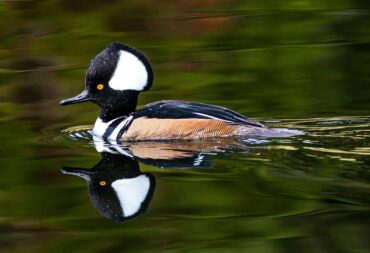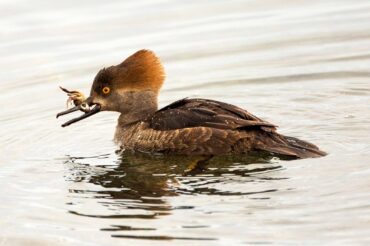
West Sound in winter is paradise for those who enjoy watching ducks. About two dozen species come to the region’s lakes, ponds, streams, bays and open saltwater from late winter to early spring.
While there are many similarities among the ducks, differences also abound. Some forage on or just below the surface while others dive for food. Some, such as wood ducks, are found in freshwater and others, such as scoters, prefer saltwater. Then there are those that utilize both freshwater and saltwater, such as mallards, buffleheads, goldeneyes and mergansers.
There are six species of mergansers in the world. The name merganser derives from the Latin words mergus (diver) and anser (goose). Despite its name, the merganser is not a goose, but a diving duck. Three species are found in North America, all of which are common on West Sound waterways in winter.
The largest and most locally abundant of the three merganser species is the common merganser. It forms small or large flocks in either freshwater or saltwater, most often on lakes and in bays near estuaries. While most breed in the Arctic, some raise their families in Western Washington on lakes, ponds and mountain rivers.
The medium-sized, red-breasted merganser is easily identified by its shaggy crest. Despite breeding on Arctic ponds and lakes, the red-breasted merganser makes its living on saltwater in the winter, usually in small flocks. It is absent from the Salish Sea in summer.
The smallest of Washington’s mergansers is the striking hooded merganser. The male is unmistakable with a magnificent white crest, outlined in black. The crest can be fanned out to attract attention or lowered behind the head for subtlety. The hooded merganser’s body is black and white, with chestnut flanks. The female is gray and brown, with a cinnamon crest that can also be raised upright or laid flat.

The hooded merganser is either migratory or a year-round resident. Breeders from northern states and southeastern Canada winter in the southern Plains states and Florida. It’s year-round in the eastern United States. The Pacific Northwest population is mostly year-round, with some inland regions getting short-distance winter migrants from British Columbia. Pockets of wintering areas are also found in the Southwest.
Forested wetland is the preferred breeding habitat for the hooded merganser. This includes anything from swamps and small ponds to large lakes and rivers. During migration and winter, the hooded merganser may remain in its breeding habitat or use estuaries and saltwater bays.
In West Sound, the hooded merganser is most common from late fall to early spring. Small flocks spend the nonbreeding season on local ponds, lakes, bays, streams and estuaries. Some pairs breed locally near secluded ponds.
Unlike other mergansers that primarily eat fish, the hooded merganser has a varied diet that includes small fish, amphibians, crustaceans, mollusks, aquatic insects and vegetation. Locating food visually with eyes that act as goggles by enabling underwater vision, the hooded merganser dives for food in shallow water. Using its feet for propulsion, it grabs hold of its prey with a slender, serrated bill.
Like wood ducks, goldeneyes and other mergansers, the hooded merganser nests in tree cavities near water. A sufficient nest spot has an entrance hole between 3 and 5 inches in diameter. The nest can be either in a live or a dead tree, likely carved out by a pileated woodpecker. Hooded mergansers also use nest boxes with wood shavings lining the bottom and prefer a site that is 10 to 50 feet above ground level. They may select a cavity that’s up to 90 feet high.
The female softens the floor of the cavity with her own downy feathers, which she pulls from her belly. She lays five to 13 eggs and incubates them for 26 to 41 days. The male doesn’t assist in raising the chicks. Like other cavity-nesting ducks, the hooded merganser is known to practice “brood parasitism,” the laying of eggs in the nests of other hooded mergansers or even other duck species. It’s possible for a nest to contain as many as 44 eggs.
Nestlings leave the nest within a day of hatching. In answer to their mother’s call, the fuzzy chicks clamber to the entrance of the nest, then leap to the ground. They then follow their mother to the nearest water, which may be a half mile away. After caring for them for about two months, the female abandons her chicks shortly before they can fly.
Populations are reasonably stable, but the hooded merganser, whose numbers are limited to begin with, faces vulnerability due to habitat loss and the lack of suitable nesting cavities.
The hooded merganser is a show stopper with its striking beauty. The unique crest allows for easy identification. It’s no surprise that this fun little duck is a favorite among birders.





























